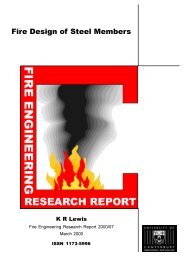compression properties of wood as functions of moisture, stress and ...
compression properties of wood as functions of moisture, stress and ...
compression properties of wood as functions of moisture, stress and ...
Create successful ePaper yourself
Turn your PDF publications into a flip-book with our unique Google optimized e-Paper software.
Second International Workshop Structures in Fire – Christchurch – March 2002 .<br />
1. Initial Input<br />
STRUCTURAL<br />
RESPONSE MODEL<br />
2. Input <strong>of</strong> Temperature<br />
Distribution in the Wall<br />
3. Determine Stiffnesses <strong>of</strong>:<br />
Elements<br />
Members<br />
Supports<br />
Frame<br />
Increment<br />
Time Step<br />
4. Determine Unbalanced Actions<br />
5. Undertake Frame Analysis to<br />
Determine Displacements<br />
6. Test Failure<br />
Yes<br />
failure<br />
No<br />
not<br />
converged<br />
yet<br />
Yes<br />
convergence achieved<br />
No<br />
no failure<br />
7. Test Convergence<br />
8. Output<br />
Figure 21. Flowchart showing overview <strong>of</strong> structural response model [6].<br />
CONCLUSIONS<br />
Creep <strong>of</strong> <strong>wood</strong> specimens h<strong>as</strong> been me<strong>as</strong>ured for a range <strong>of</strong> loads, <strong>moisture</strong> contents <strong>and</strong><br />
temperatures. The significant types <strong>of</strong> creep observed were:<br />
• Creep due to the presence <strong>of</strong> <strong>moisture</strong>, heat <strong>and</strong> <strong>stress</strong> in the temperature range 20°-<br />
100°C.<br />
• Creep due to heat <strong>and</strong> <strong>stress</strong> in the temperature range 100°-300°C.<br />
Experimentation involving desorption <strong>of</strong> <strong>moisture</strong> in <strong>wood</strong> specimens did not reveal significant<br />
creep due to mechano-sorptive effects.<br />
The first type <strong>of</strong> creep mentioned above w<strong>as</strong> sufficient for explaining the difference between the<br />
el<strong>as</strong>tic modulus obtained by calibration <strong>and</strong> direct me<strong>as</strong>urement.<br />
The relationships for the el<strong>as</strong>tic modulus <strong>of</strong> <strong>wood</strong> in <strong>compression</strong> obtained by several<br />
researchers through the calibration <strong>of</strong> models to full scale experiments represent simple el<strong>as</strong>tocreep<br />
models for predicting the effects <strong>of</strong> creep <strong>of</strong> light-timber structures in fire. The models are<br />
limited to applications in which the <strong>wood</strong> is subjected to temperatures, <strong>moisture</strong>s <strong>and</strong> <strong>stress</strong>es<br />
similar to values that occurred in the experiments.<br />
240
















